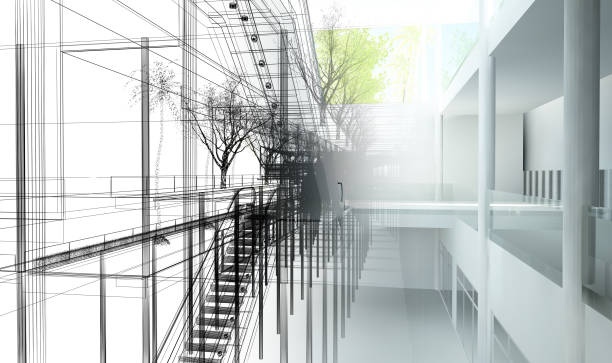Designing for Wellbeing: How Architecture Affects Mental and Physical Health
In our increasingly urbanized and fast-paced world, where stress and mental health issues are prevalent, the design of our built environment plays a pivotal role in shaping our overall wellbeing. Architecture goes beyond mere functionality and aesthetics—it has the power to influence our mental and physical health and well-being in profound ways.
Research has shown that well-designed buildings and public spaces can have a positive impact on our mental health. Natural light, open spaces, and access to greenery have been shown to reduce stress and improve mood. Additionally, buildings that are designed with acoustics in mind can help to create a peaceful and quiet environment, which is crucial for reducing anxiety and increasing concentration.

From promoting relaxation and reducing stress to encouraging physical activity and fostering social connections, thoughtful architectural design can significantly enhance our quality of life. This comprehensive exploration delves into the intricate relationship between architecture and wellbeing, examining how different design elements can impact mental and physical health positively.
One of the key aspects of promoting wellbeing through architecture is the incorporation of natural elements into the design. Biophilic design, which seeks to connect people with nature, has been shown to have numerous benefits for mental health. Views of green spaces, natural light, and access to outdoor areas can all contribute to reducing stress levels and promoting relaxation. In addition, research has shown that exposure to natural elements can have a positive impact on cognitive function and overall mood.
Understanding Wellbeing in Architectural Design
Wellbeing encompasses both mental and physical health, as well as social and environmental factors. In architectural design, creating spaces that support well-being involves considering aspects such as: social connections, accessibility, and environmental psychology.

1. Biophilic Design: Incorporating natural elements like greenery, natural light, and water features into architectural spaces. Biophilic design aims to reconnect humans with nature, which has been shown to reduce stress levels, improve cognitive function, and enhance overall mood.
2. Sustainable and Healthy Materials: Using materials that promote indoor air quality and sustainability. This includes materials low in volatile organic compounds (VOCs), which can contribute to better respiratory health and overall comfort, thereby improving the well-being of occupants.
3. Accessibility: Designing spaces that are inclusive and accessible to people of all ages and abilities. Accessibility features not only cater to physical needs but also contribute to a sense of equity and social inclusion, essential aspects of holistic urban design.
4. Social Connectivity: Creating environments that facilitate social interactions and community engagement. Well-designed public spaces and communal areas encourage social cohesion and reduce feelings of isolation.
5. Active Design: Encouraging physical activity through building layouts that promote movement, such as incorporating stairs, walkable neighborhoods, and access to recreational facilities, crucial for physical and mental well-being.
The Impact of Architecture on Mental Health

Biophilic Design and Stress Reduction
Biophilic design principles suggest that incorporating natural elements into architectural spaces can have profound effects on reducing stress and anxiety. Natural light, for instance, not only reduces the need for artificial lighting but also positively influences circadian rhythms, which regulate our sleep-wake cycle. Exposure to natural light has been linked to improved mood and increased productivity, enhancing overall health and well-being.
In addition to natural light, integrating indoor plants, water features, and views of nature can contribute to a calming environment. Studies have shown that interactions with nature, even within urban contexts, can lower cortisol levels (a stress hormone) and promote relaxation, underscoring the importance of environmental psychology in urban design.
Indoor Air Quality and Wellbeing
The quality of indoor air is another critical factor in architectural design. Poor indoor air quality, often caused by inadequate ventilation and off-gassing from materials, can lead to respiratory issues and discomfort. Designing buildings with efficient ventilation systems and using low-emission materials can significantly improve indoor air quality, thereby enhancing occupant health and wellbeing.
Noise Reduction and Mental Health
Noise pollution is a pervasive issue in urban environments and can negatively impact mental health, affecting overall emotional well-being. Architectural solutions such as sound-absorbing materials, double-glazed windows, and strategic building layouts can help mitigate noise pollution. Reduced exposure to noise has been associated with improved concentration, better sleep quality, and overall psychological wellbeing.
The Influence of Architecture on Physical Health
The physical environment and architectural design play a significant role in influencing the overall quality of life and physical well-being of individuals. Through systematic reviews, it has been found that the design of interior spaces, building materials, and biophilic elements can impact mental health and well-being. Therapeutic spaces in settings such as psychiatric hospitals are designed with psychosocially supportive design to enhance the quality of care and promote psychological well-being. The atmosphere created through interior design and sensory design can evoke emotional responses and provide a sense of control for individuals.

The use of privacy policies and considerations for multiple senses in the indoor environment of a psychiatric hospital can greatly impact the mental well-being of patients. By integrating elements of nature and materiality into the design, the physical environment can become a therapeutic space that promotes healing and recovery. Creating a sense of comfort and security in the interior spaces through thoughtful interior design can lead to positive emotional responses and overall well-being.
Promoting Physical Activity
Architectural design can encourage physical activity by creating environments that support active lifestyles. This includes designing buildings with accessible stairs, well-lit pedestrian pathways, and proximity to parks or recreational facilities. Promoting physical activity not only improves cardiovascular health and reduces the risk of chronic diseases but also enhances overall fitness and wellbeing.
Walkable Neighborhoods and Community Design
The layout of neighborhoods and communities also plays a crucial role in promoting physical activity and social interaction, highlighting the importance of a well-being focused design approach. Walkable neighborhoods with mixed land uses, pedestrian-friendly streets, and public amenities encourage residents to engage in active transportation and interact with their surroundings. Community design that prioritizes public spaces, such as parks, playgrounds, and communal gardens, fosters social connections and a sense of belonging, key components of urban design.
Social Connections and Community Wellbeing
Social Connections and Community Wellbeing are crucial components in promoting positive mental wellbeing. The relationship between architectural space and mental health is well documented, with design in architecture playing a significant role in enhancing both mental and physical well-being. In the field of architectural design, the benefits of biophilic design have been increasingly recognized for their ability to create a biophilic environment that enhances mental health. Researchers in the school of architecture have found that design patterns that incorporate elements of nature can have a profound impact on human emotions and the role of the human senses in shaping the experience of architectural spaces.

Furthermore, the physical design of spaces impact mental health care, particularly in mental health facilities where individuals suffering from mental illnesses require specialized environments for their well-being. By implementing a biophilic approach to design in these settings, it is possible to promote positive outcomes and improve the overall mental wellbeing of those in need.
Designing for Social Interaction
Architecture can facilitate social connections by creating spaces that encourage interaction and collaboration, a holistic design approach that architects and designers should prioritize. Well-designed public spaces, community centers, and shared amenities provide opportunities for people to come together, build relationships, and strengthen community bonds, contributing to social well-being. These interactions contribute to a sense of belonging and social support, which are vital for mental and emotional well-being.
Inclusive Design and Social Equity
Inclusive design principles aim to create environments that are accessible and equitable for people of diverse backgrounds and abilities. Designing with inclusivity in mind promotes social equity and ensures that everyone has equal access to resources and opportunities within their built environment. This can foster a sense of community pride and empowerment among residents.
Future Trends in Wellbeing-Oriented Architecture
As society continues to evolve, so too does our understanding of the relationship between architecture and wellbeing. Emerging trends in wellbeing-oriented architecture include:

Green Building Certifications: Increasing demand for buildings certified under green building standards, which prioritize sustainability and occupant health.
Technology Integration: Utilizing smart technologies to monitor and improve indoor environmental quality, optimize energy use, and enhance user comfort.
Adaptive Reuse: Repurposing existing buildings to meet modern sustainability and wellbeing standards, reducing environmental impact and preserving cultural heritage.
Mindful Design: Incorporating mindfulness principles into architectural practice, such as designing spaces that promote mindfulness meditation and relaxation.
Conclusion
Architecture is more than just constructing buildings; it is about creating environments that support and enhance our mental, physical, and social wellbeing. By integrating principles of biophilic design, sustainability, accessibility, and social connectivity, architects can design spaces that positively impact our health and quality of life. As we continue to innovate and prioritize wellbeing in architectural practice, we move towards creating a built environment that not only sustains us physically and mentally but also enriches our lives in meaningful and profound ways. By recognizing the transformative power of architecture, we have the opportunity to create healthier, happier, and more resilient communities for generations to come.







